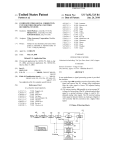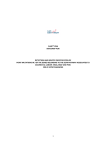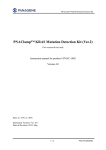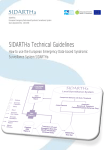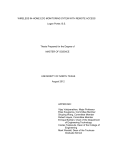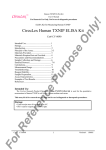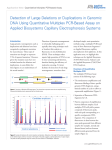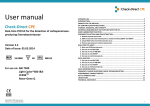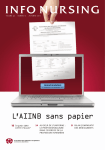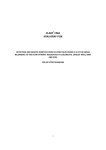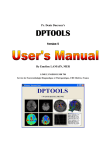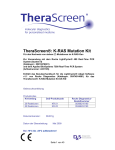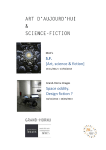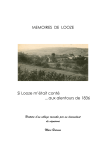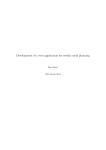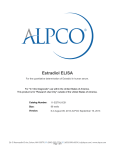Download TheraScreen®: K-RAS Mutation Kit
Transcript
TheraScreen®: K-RAS Mutation Kit For the Detection of 7 Mutations in the K-RAS Gene For use on the Roche LightCycler® 480 Real-Time PCR System (Instrument II) (Catalogue #: 05015278001) And the Applied BioSystems 7500 Real-Time PCR System (Part Number: 4351105) Includes the user manual for the LightCycler® Adapt Software v1.1 from Roche Diagnostics (Catalogue # 05474914001) for the TheraScreen®: K-RAS Mutation Kit CE-IVD Instructions for Use Product Codes Kit Size DxS Product Code 20 Reactions 80 Reactions KR-21 KR-22 Instructions Version: DU001f Date of Revision: February 2009 Store at -18oC to -25˚C Page 1 of 38 Roche Diagnostics Ordering Number 05366216190 05366224190 For Diagnostic Use Only TheraScreen: K-RAS Mutation Kit Contents 1. Intended Use / Indications for Use ............................................................................... 3 2. Summary and Explanation of the Test. ........................................................................ 3 3. Technological Principles ................................................................................................. 4 4. Reagents ............................................................................................................................ 6 5. WARNINGS AND PRECAUTIONS ........................................................................... 7 6. Storage, Stability and Shipping Conditions .................................................................. 8 7. Instrument. ........................................................................................................................ 9 8. Specimens .......................................................................................................................... 9 9. K-RAS Mutation Detection Protocol......................................................................... 14 10. Limitations of the Test .............................................................................................. 25 11. Assay Performance Characteristics ......................................................................... 26 12. Technical Assistance ................................................................................................... 34 13. Manufacturer and Distributor Details ..................................................................... 35 14. Date of issuance of last revision ............................................................................... 35 15. References .................................................................................................................... 36 Notes To The Purchaser: ................................................................................................. 38 Page 2 of 38 For Diagnostic Use Only TheraScreen: K-RAS Mutation Kit IMPORTANT: Read these instructions carefully and become familiar with all components of the K-RAS Kit prior to use. 1. Intended Use / Indications for Use Intended Use The DxS TheraScreen®: K-RAS Mutation Kit (K-RAS Kit) is an in vitro diagnostic test intended for the detection of seven somatic mutations in the K-RAS oncogene and will provide a qualitative assessment of mutation status. The K-RAS Kit is to be used by trained personnel in a professional laboratory environment with DNA samples extracted from formalin fixed paraffin-embedded colorectal tissue. Indications for use. The results of the K-RAS Kit are intended to aid the clinician in identifying colorectal cancer patients who may not benefit from anti-epidermal growth factor receptor (EGFR) therapy, such as panitumumab or cetuximab. The K-RAS Kit is not intended to diagnose colorectal cancer. It is intended as an adjunct to other relevant prognostic factors used to select suitable patients for treatment with anti-EGFR therapies, based on the patient’s mutation status. The patient’s mutation status will be considered by a Clinician, alongside other disease factors to make a therapy decision. No treatment decision for cancer patients should be based on K-RAS mutation status alone. 2. Summary and Explanation of the Test. The K-RAS kit is a CE- marked diagnostic device in accordance with the European Union in vitro Diagnostic Medical Device Directive 98/79/EC. Mutations in the K-RAS oncogene are frequently found in human cancers (1-4). The presence of these mutations correlates with a lack of response to certain EGFR inhibitor cancer therapies, in metastatic colorectal cancer patients (5-10)(14-21). Detection of seven mutations in the K-RAS gene is possible in a background of wild-type genomic DNA in a real-time PCR assay based on DxS Scorpions technology. This method is highly selective. Providing there are enough copies of DNA, detection of approximately 1% mutant in a background of wild-type genomic DNA is possible. The K-RAS Kit will detect seven K-RAS mutations in codons 12 and 13 of the K-RAS oncogene, as shown in Table 1. Page 3 of 38 For Diagnostic Use Only TheraScreen: K-RAS Mutation Kit Table 1: K-RAS Mutations Detected by the DxS Kit COSMIC ID’s are taken from the Catalogue of Somatic Mutations in Cancer http://www.sanger.ac.uk/genetics/CGP/cosmic/ Mutation Gly12Ala Gly12Asp Gly12Arg Gly12Cys Gly12Ser Gly12Val Gly13Asp Base Change Cosmic ID (GGT>GCT) 522 (GGT>GAT) 521 (GGT>CGT) 518 (GGT>TGT) 516 (GGT>AGT) 517 (GGT>GTT) 520 (GGC>GAC) 532 3. Technological Principles The K-RAS Kit combines two technologies, ARMS® and Scorpions® (11, 12, 13), to detect mutations in real-time PCR assays. ARMS Allele or mutation specific amplification is achieved by ARMS. Taq DNA polymerase is extremely effective at distinguishing between a match and a mismatch at the 3’-end of a PCR primer. Specific mutated sequences can be selectively amplified, even in samples where the majority of the sequences do not carry the mutation as: • When the primer is fully matched, the amplification proceeds with full efficiency. • When the 3’-base is mismatched, only low level background amplification occurs. Scorpions Detection of amplification is performed using Scorpions. Scorpions are bi-functional molecules containing a PCR primer covalently linked to a probe. The fluorophore in this probe interacts with a quencher, also incorporated into the probe, which reduces fluorescence. During a PCR reaction, when the probe binds to the amplicon, the fluorophore and quencher become separated. This leads to an increase in fluorescence from the reaction tube. Data Analysis: ∆Ct Method Scorpions real-time assays use the number of PCR cycles necessary to detect a fluorescent signal above a background signal, as a measure of the target molecules present at the beginning of the reaction. The point at which the signal is detected above background fluorescence is called the ‘cycle threshold’ (Ct). Sample ∆Ct values are calculated as the difference between the mutation assay Ct and control assay Ct from the same sample. Samples are classed as mutation positive if they give a ∆Ct less than the 1% ∆Ct value for that assay. Page 4 of 38 For Diagnostic Use Only TheraScreen: K-RAS Mutation Kit Above this value, the sample may either contain less than 1% mutation (beyond the limit of the assays), or the sample is mutation negative. When using ARMS primers some inefficient priming may occur, giving a very late background Ct from DNA not containing a mutation. All ∆Ct values calculated from background amplification will be greater than the 1% ∆Ct values and the sample will be classed mutation negative. The K-RAS Kit is CE marked for in vitro diagnostic use on either the Roche Diagnostics LightCycler® 480 Real-Time PCR System (Instrument II) (LightCycler® 480 Instrument) 96 well format, Roche Part Number: 05015278001 or Applied BioSystems 7500 Real-Time PCR System, part number 4351105 (ABI7500). For the LightCycler® 480 Instrument, the K-RAS Kit must be used in combination with the LightCycler® Adapt Software v1.1 for the TheraScreen® K-RAS Mutation Kit CE-IVD (LightCycler® Adapt Software). This software has been developed to automate the calling of a positive or negative amplification plot and computes a suitable threshold from which to obtain Ct values. These are used to calculate sample ∆Ct values, which are compared with the 1% cut-off values. The software reports a positive or negative mutation result and removes any subjectivity from the analysis and interpretation of the K-RAS Kit data. K-RAS Kit Format Eight assays are supplied in the K-RAS Kit. • One control assay. • Seven mutation assays. All reaction mixes contain an exogenous control (internal control) assay labelled with HEX (to be detected by the JOE detector on the ABI7500). This controls for the presence of inhibitors which may lead to false negative results. Control assay The control assay, labelled with FAM, is used to assess the total DNA in a sample. The control assay amplifies a region of exon 4 of the K-RAS gene. The primers and probe have been designed to avoid any known K-RAS polymorphisms. Mutation assays Each mutation assay, labelled with FAM, contains one Scorpion plus one ARMS primer, for discrimination between the wild-type DNA and the mutant DNA detected by a real-time PCR assay. Page 5 of 38 For Diagnostic Use Only TheraScreen: K-RAS Mutation Kit 4. Reagents This K-RAS Kit contains sufficient reagents to perform quality assessment of samples and run the K-RAS assays for up to 20 or 80 reactions, dependent on kit size. Kit Size DxS Product Code Roche Diagnostics Ordering Number 20 Reactions KR-21 05366216190 80 Reactions KR-22 05366224190 The number of samples that can be tested is dependent on sample batch size. Table 2: K-RAS Kit Contents 20 reactions 80 reactions Volume Volume Control Reaction Mix 1300 µl 5200 µl 12ALA Reaction Mix 650 µl 2600 µl 12ASP Reaction Mix 650 µl 2600 µl 12ARG Reaction Mix 650 µl 2600 µl 12CYS Reaction Mix 650 µl 2600 µl 12SER Reaction Mix 650 µl 2600 µl 12VAL Reaction Mix 650 µl 2600 µl 13ASP Reaction Mix 650 µl 2600 µl Mixed standard 300 µl 1000 µl Taq DNA polymerase 60 µl 240 µl Reagents Supplied Tube 1 2 3 4 5 6 7 8 9 10 Equipment and Reagents Not Supplied With K-RAS Kit The user will require the following equipment and consumables: • The LightCycler® 480 Instrument or the ABI7500 Real-time PCR Machine, capable of cycling as defined in Section 9; K-RAS Mutation Detection Protocol. • The LightCycler® Adapt Software v1.1 from Roche Diagnostics (Catalogue # 05474914001). • 0.2 ml DNAse-free PCR plates (LightCycler® 480 Instrument Multiwell Plate 96, catalogue number 04729692 001, or ABI MicroAmp Optical 96well reaction Plate, part number 4306737, with MicroAmp Optical Adhesive Film, part number 4311971). • Sterile tubes for preparing master mixes. • Dedicated pipettes for PCR mix preparation. • Dedicated pipettes for dispensing of DNA template. • Sterile, nuclease-free H20. Page 6 of 38 For Diagnostic Use Only TheraScreen: K-RAS Mutation Kit 5. WARNINGS AND PRECAUTIONS For In Vitro Diagnostic Use. The K-RAS Kit is not intended to screen for or to diagnose any type of cancer including colorectal cancer. It is intended to be used as an adjunct to other prognostic factors currently used to select patients who would not benefit from anti-EGFR cancer therapies. Therapy for cancer patients should not be based on K-RAS gene mutation status alone. A clinician should consider the mutation status of the patient alongside other disease factors. The contents of the K-RAS Kit may be freeze-thawed up to 8 times without an adverse effect on assay performance. DO NOT freeze-thaw the K-RAS Kit reagents more than 8 times. Note that tumour samples are non-homogeneous and data from a sample of tumour may not be concordant with other sections from the same tumour. Tumour samples may also contain non-tumour tissue. DNA from nontumour tissue would not be expected to contain the K-RAS mutations detected by the K-RAS Kit All assays in the K-RAS Kit generate short PCR products. However, the K-RAS Kit will not work on heavily fragmented DNA. DNA assessment should be based on PCR and may differ from quantification based on Optical Density readings. Additional control reaction mix is supplied to allow assessment of quality and quantity of the DNA in samples before running the K-RAS Kit. Reagents for the K-RAS Kit have been diluted optimally. Further dilution of the reagent is not recommended and will result in a loss of performance. Use of less than 25 µl reaction volumes is not recommended and will increase the risk of false negatives. All reagents in the K-RAS Kit are formulated specifically for use with the stated tests. No substitutions should be made to the K-RAS Kit reagents if optimal performance is to be maintained. To ensure optimal activity and performance Scorpions primers (as with all fluorescently labelled molecules) should be protected from light to avoid photo bleaching. Use extreme caution to prevent contamination of PCR reactions with synthetic control material. It is recommended that separate, dedicated pipettes be used for setting up reaction mixes and adding DNA template. The preparation and dispensing of reaction mixes should be carried out in a separate area to the addition of template. Tubes should never be opened after a PCR reaction. Page 7 of 38 For Diagnostic Use Only TheraScreen: K-RAS Mutation Kit Each assay included in the K-RAS Kit has its own characteristics. Calculation of the result must be made with reference to the correct assay parameters, (see Report/Data Interpretation section). Mutation Ct values of 38 or above must be scored as negative or below the limits of the kit. The assays contain an exogenous control reaction (internal control) in addition to the reaction of interest (see Technological Principles section). If both assays have failed the data must be discarded as there may be inhibitors present that could lead to false negative results. Diluting the sample may reduce the effect of inhibitors but it should be noted that this would also dilute down the DNA. General laboratory precautions should be used, including but not limited to: a) Do not pipette by mouth b) Do not smoke, eat or drink in areas where specimens or kit reagents are being handled c) Wash hands after performing the test Only use the Taq polymerase (Taq) that is provided in the kit, do not substitute with Taq from other kits of the same or any other type, or with Taq from another supplier. Only thaw the reagents required for each run, do not thaw the whole kit each time, in order to minimise the amount of freeze/thaw cycles. Safety Information Caution: All chemicals and biological material should be considered as potentially hazardous. Specimens are potentially infectious and should be treated accordingly. The K-RAS Kit should be used only by those persons who have been trained in the appropriate laboratory techniques. When working with the components of this K-RAS Kit always wear a suitable lab coat, disposable gloves and safety glasses. After use, K-RAS Kit components should be disposed of as clinical waste. 6. Storage, Stability and Shipping Conditions Storage All the contents of the K-RAS Kit should be stored immediately upon receipt at -18oC to -25˚C, in the dark in a constant temperature freezer. Avoid unnecessary freeze thawing of the contents of the K-RAS Kit. Page 8 of 38 For Diagnostic Use Only TheraScreen: K-RAS Mutation Kit Stability Do not use the K-RAS Kit after the stated expiry date. The contents of the K-RAS Kit are stable until the expiry date when stored under the recommended storage conditions and in the original packaging. The contents of the K-RAS Kit may be freeze-thawed up to 8 times without an adverse effect on assay performance. DO NOT freeze-thaw the K-RAS Kit reagents more than 8 times. Shipping Conditions The contents of the K-RAS Kit are shipped on dry ice and should still be frozen on arrival. If the K-RAS Kit is not frozen on arrival, the outer packaging has been opened during transit, the shipment does not contain a packing note, instructions for use or the reagents, please contact your local Roche Diagnostics Office; see section 12, Technical Assistance for Contact Details. 7. Instrument. Refer to the instrument user manual for complete instructions on the installation and use of the real-time PCR instrument. 8. Specimens Specimen material must be human genomic DNA, extracted from formalin fixed paraffin embedded colorectal tumour samples. Specimen Collection and Preparation 1. Specimen Transport: Standard pathology methodology to ensure specimen quality. 2. Recommended Sample Extraction Process: DNA extraction, using the Qiagen QIAamp® DNA FFPE tissue kit (catalogue number 56404). The following amendments to the Qiagen protocol must be used:• • FFPE sections must be collected onto glass slides. Excess paraffin must be scraped away from around the tissue sections using a fresh, sterile scalpel. • Scrape tissue section material into micro centrifuge tubes using a fresh scalpel for each sample to be extracted. • Proteinase K digestion must be continued until completion. This may take up to 48 hours. • The samples must be eluted into 200 µl of ATE buffer from the Qiagen extraction kit. Any alternative methods of sample preparation must be validated by the enduser. 3. Extracted DNA storage: Store at -20˚C, prior to analysis. Page 9 of 38 For Diagnostic Use Only TheraScreen: K-RAS Mutation Kit Sample Assessment Protocol The extra control assay mix supplied with the K-RAS Kit must be used to assess the total DNA in a sample. The control assay amplifies a region of exon 4 of the K-RAS gene. Samples should be set up with only the control assay using the mixed standard as a positive control and water as the no template control. Note that to obtain the optimal use of the reagents in the K-RAS kit samples should be batched. All experimental runs must contain controls. If samples are tested individually this will use up more reagents and reduce the number of samples that can be tested with the K-RAS Kit. Sample Assessment Protocol-Plate Setup 1. Thaw the control reaction mix and mixed standard from the K-RAS Kit, at room temperature. Mix each solution by inverting each tube 10 times, once thawed, to avoid localised concentrations of salts. Prepare sufficient mixes for the DNA samples, one mixed standard reaction and one no template control reaction, plus an excess of 2 reactions. 2. To make the master mix use the amounts of reagents per reaction as given in Table 3. Table 3: Control Assay Master Mix Volumes Assay Control assay Master Mix Reaction Mix (µl)x1 Taq (µl)x1 19.8 0.2 3. DO NOT vortex the Taq, or any reaction mixes that contain Taq, as this may cause inactivation of the enzyme. 4. Ensure that the Taq is at room temperature before use. Spin the vial to ensure all the Taq is collected at the bottom of the vial then pipette by placing the pipette tip just under the surface of the Taq, to minimise the risk of the tip getting coated in excess Taq. 5. Mix the master mix by gently pipetting up and down. 6. Immediately add 20 µl of the control master mix to each of the reaction wells. 7. Immediately add 5 µl of sample, mixed standard or water (for the no template controls) to the reaction wells. 8. The plate must be set up with the mixed standard added to well A1 and no template control (water) added to A2. All other wells in use must contain the samples. 9. Seal and spin the PCR plate briefly to collect the reagents at the bottom of the wells. Page 10 of 38 For Diagnostic Use Only TheraScreen: K-RAS Mutation Kit 10. Follow the instrument setup for the appropriate platform. Sample Assessment Protocol – LightCycler® 480 Instrument Setup 1. Immediately place the plate into the LightCycler® 480 Instrument. 2. Select the LightCycler® 480 Software icon on the desktop of the workstation attached to the instrument. Log into the software and from the ‘Overview’ screen select ‘New Experiment from Template’. From the run templates listed choose ‘K-RAS LC480II Run Template’. This template will have the following parameters:- 3. 4. 1. Detection Format is ‘DxS IVD Assays’. 2. Reaction Volume is 25. 3. An initial hold step at 95˚C for 4 minutes. 4. A 2-step amplification for 45 cycles with a denaturation at 95˚C for 30 seconds and annealing at 60˚C for 1 minute. The fluorescence acquisition is a single acquisition at the 60˚C step. Select the ‘Sample Editor’ tab and under ‘Step 1: Select Workflow’ select the ‘Abs Quant’ tick box. Under ‘Select Filter Combinations’, ensure both filters are selected (465-510 nm and 533-580 nm). Set up the samples names under Step 2 and Step 3. The Quantification Sample Type should be set as ‘unknown’. The replicate column should be left blank. . Select the ‘Experiment’ button and click the ‘Start Run’ button to save the experiment and start the cycling. 5. On completion of the run, select the ‘Analysis’ tab and chose ‘Abs Quant/2nd Derivative Max’ from the ‘Create New Analysis’ window. Accept the defaults from the ‘Create New Analysis’ Screen. Ensure that the ‘Filter Comb’ button is ‘465-510’ and select the ‘Calculate’ button. Ct values are displayed in the ‘Samples’ table. 6. Select the ‘Filter Comb’ button and change the filters to 533-580 nm. Select the ‘Calculate’ button and obtain the exogenous control Ct values from the ‘Samples’ table. Page 11 of 38 For Diagnostic Use Only TheraScreen: K-RAS Mutation Kit Sample Assessment Protocol-ABI7500 Instrument Setup 1. Immediately place the plate into the ABI7500 instrument. 2. Select the 7500 System Software icon on the desktop of the workstation attached to the instrument. Open a new run file from the file menu in the 7500 Sequence Detection Software version 1.4. 3. Under ‘Assay’ select ‘Standard Curve (Absolute Quantification)’. Under ‘Run Mode’ select ‘Standard 7500’. 4. Move to the detector setup window by selecting the ‘Next’ button. Add a FAM and a JOE detector, with quenchers set to ‘none’, to the detectors list. If these detectors do not already exist select the ‘New Detectors’ button and set up a FAM and a JOE detector with the quencher set to ‘none’. 5. Set the ‘Passive Reference’ to ‘None’ and select the ‘Next’ button. 6. Select the entire plate and check the tick boxes for the FAM and JOE detectors to ensure that both dyes are monitored in each well. Select the ‘Finish’ button. 7. Under the ‘Instrument’ tab set up the cycling as given in Table 4. Table 4: ABI7500 Cycling Conditions Temperature Stage 1 95oC Stage 2 95oC 60oC Time Cycles 4 min 1 30 sec 1 min 40 Data Collection FAM, JOE 8. Select the ‘Start’ button to save the experiment and start the cycling. 9. On completion of the run ensure that the passive reference is set to ‘none’ in the well inspector screen. In the Amplification Plot tab select all the wells in use and select the JOE dye from the detector drop down menu. 10. Check the JOE signal from each sample and compare to the JOE signal in the NTC well. Note any samples that have a later amplification curve or failed amplification for the exogenous control as compared to the NTC. 11. In the Amplification Plot tab select all the wells in use and select the FAM from the detector drop down menu. Use the automatic baseline setting manual Ct and then set the threshold manually in the middle of exponential phase, using the log scale for the Y axis, as described in ABI7500 user guide. 12. Select the ‘Analyse’ button to obtain Ct values. Page 12 of 38 dye and the the For Diagnostic Use Only TheraScreen: K-RAS Mutation Kit Sample Assessment Interpretation Assess the NTC Ct values to ensure that there is no contamination giving a positive amplification in the FAM channel (Ct less than 40) or a failed exogenous control reaction in the HEX channel (no Ct), indicating a setup problem. The mixed standard should give a control assay Ct (FAM channel) of 26-29 on the ABI7500 and ≤ 29 on the LightCycler® 480 Instrument. Data should not be used if either of these 2 run controls has failed. Control assay Ct 29-35: Interpret with caution as very low level mutations may not be detected. Control assay Ct 35-38. Only a few amplifiable copies of DNA are present in such samples and mutations are only likely to be seen if most copies are mutated. Control assay Ct ≥ 38: Reject sample, as there is minimal DNA present and the K-RAS Kit will not be able to detect mutations. Note that if a sample gives a late control assay Ct, the sample exogenous control Ct should be compared with the exogenous control of the NTC. If the exogenous control of the sample is delayed or negative, as compared to the NTC, an inhibitor may be present. It is possible to reduce the effect of an inhibitor by diluting the sample, although this will also dilute the DNA. Sample Dilution: A Control Ct of < 24 will overload the mutation assays. Samples with a control Ct of < 24 must be diluted. It should be noted that, for the LightCycler® 480 Instrument, Ct values obtained through the 2nd derivative method may be slightly different to those obtained with LightCycler® Adapt Software. It is recommended that concentrated samples are diluted to fall within the >24 but < 29 range (Ct values based on the 7500 Sequence Detection Software or LightCycler® 480 Instrument Software) using the basis that diluting ½ will increase the Ct by 1. Page 13 of 38 For Diagnostic Use Only TheraScreen: K-RAS Mutation Kit 9. K-RAS Mutation Detection Protocol Read these instructions carefully and become familiar with all components of the K-RAS Kit prior to use. To use the K-RAS Kit efficiently samples must be batched into a batch size of 10 (to fill one 96 well plate). Smaller batch sizes will mean that fewer samples can be tested with the K-RAS Kit. LightCycler® 480 Instrument Experimental Setup For each DNA sample the control and mutation assays must be analysed on the same PCR run to avoid run-to-run variations. 1. Thaw the reaction mixes and mixed standard from the K-RAS Kit, at room temperature. Mix each solution by inverting each tube 10 times, once thawed, to avoid localised concentrations of salts. Prepare sufficient mixes for the DNA samples, the mixed standard and no template controls, plus an excess of 2 reactions per mix as shown in Table 5. Table 5: K-RAS Master Mix volumes Assay Control assay Mutation assays Reaction Mix (µl)x1 19.8 19.8 Master Mixes Reaction Mix (µl) Taq (µl)x1 per plate (x14) 0.2 0.2 Taq (µl)per plate 277.2 277.7 (x14) 2.8 2.8 2. DO NOT vortex the Taq, or any reaction mixes that contain Taq, as this may cause inactivation of the enzyme. 3. Ensure that the Taq is at room temperature before use. Spin the vial to ensure that all the Taq is collected at the bottom, then pipette by placing the pipette tip just under the surface of the Taq, to minimise the risk of the tip getting coated in excess Taq. 4. Mix the master mixes by gently pipetting up and down. 5. Immediately add 20 µl of the master mixes to the reaction wells. 6. Immediately add 5 µl of sample, mixed standard or water (for the no template controls) to the reaction wells. Each DNA sample must be tested with both the control and all mutation assays. The plate setup is given in Table 6. Page 14 of 38 For Diagnostic Use Only TheraScreen: K-RAS Mutation Kit Table 6: K-RAS Kit Plate Layout 96 well layout Assay A Control B 12ALA C 12ASP D 12ARG E 12CYS F 12SER G 12VAL H 13ASP 1 2 3 4 5 6 7 8 9 10 11 12 Mixed standard NTC Sample1 Sample 2 Sample 3 Sample 4 Mixed standard NTC Sample1 Sample 2 Sample 3 Sample 4 Sample 5 Sample 6 Sample 7 Sample 8 Sample 9 Sample 10 Mixed standard NTC Sample1 Sample 2 Sample 3 Sample 4 Sample 5 Sample 6 Sample 7 Sample 8 Sample 9 Sample 10 Mixed standard NTC Sample1 Sample 2 Sample 3 Sample 4 Sample 5 Sample 6 Sample 7 Sample 8 Sample 9 Sample 10 Mixed standard NTC Sample1 Sample 2 Sample 3 Sample 4 Sample 5 Sample 6 Sample 7 Sample 8 Sample 9 Sample 10 Mixed standard NTC Sample1 Sample 2 Sample 3 Sample 4 Sample 5 Sample 6 Sample 7 Sample 8 Sample 9 Sample 10 Mixed standard NTC Sample1 Sample 2 Sample 3 Sample 4 Sample 5 Sample 6 Sample 7 Sample 8 Sample 9 Sample 10 Mixed standard NTC Sample1 Sample 2 Sample 3 Sample 4 Sample 5 Sample 6 Sample 7 Sample 8 Sample 9 Sample 10 Sample 5 Sample 6 Sample 7 Sample 8 Sample 9 Sample 10 7. Seal and spin the PCR plate briefly to collect the reagents at the bottom of the wells. 8. Immediately place the plate into the LightCycler® 480 instrument. LightCycler® 480 Instrument Setup 1. Select the LightCycler® 480 Instrument software icon on the desktop of the workstation attached to the instrument. Log into the software and from the overview page select ‘New Experiment from Template’. 2. Choose the ‘K-RAS LC480II Run Template’ from the Run Templates list (see LightCycler® 480 Instrument sample assessment section for details). 3. Select the ‘Sample Editor’ tab and under ‘Step 1: Select Workflow’ select the ‘Abs Quant’ tick box. Under ‘Select Filter Combinations’ ensure both filters are selected (465-510 nm and 533-580 nm). Set up the samples names under Step 2 and Step 3. In column 1 the sample name must be Mixed Standard. In column 2 the sample name must be NTC. In columns 3-12 sample names should be entered. The names must be identical for all wells in 1 column. The Quantification Sample Type should be set as ‘unknown’. The replicate column should be left blank as replicates are not taken into account by the LightCycler® Adapt Software. 4. Select the ‘Experiment’ button and click the ‘Start Run’ button to save the experiment and start the cycling. Page 15 of 38 For Diagnostic Use Only TheraScreen: K-RAS Mutation Kit LightCycler® 480 Instrument Sample Analysis 1. On completion of the LightCycler® 480 Instrument run, using the navigator window, export the experiment (.ixo file) to a suitable location that can be accessed by the LightCycler® Adapt Software. 2. IMPORTANT: The LightCycler® Adapt Software is validated for use on a single computer system which is defined as a single control unit (workstation) provided by Roche Diagnostics for use with a single LightCycler® 480 Instrument II. This validation of the LightCycler® Adapt Software is currently only for the control unit which is a “standalone” computer (i.e. not part of a network). The use of any other computer is prohibited as the software may not perform as intended. 3. Open the LightCycler® Adapt Software by clicking on the LightCycler® Adapt Software icon on the desktop of the workstation and fill in the username field. This name will be entered as the report author. 4. In the main window use the browser button to select a single LightCycler® 480 Instrument run file (To remove a selection the software must be closed and reopened). 5. Select a report type (pdf or csv). automatically created in addition. If csv is chosen then a pdf version is 6. Select ‘Analyse’ to create the results report. The report is saved automatically in the folder containing the run file and is given the same name as the run file. 7. The report will be displayed automatically. 8. The reportable result is displayed in the ‘Mutation Status’ column of the ‘Sample Result Table’. LightCycler® Adapt Software Report Interpretation 1. The LightCycler® Adapt Software report contains general information about the analysis. 1.1. The report author is the person who has run the software and created the report. 1.2. The date and time of analysis is given. 2. The report gives an analysis overview detailing the run file name used plus the algorithm definition file and algorithm sequence. The algorithm details are fixed and cannot be altered. 3. The results section details the full name and file path of the LightCycler® 480 Instrument run plus the following details: 3.1. The LightCycler® 480 Instrument serial number. 3.2. Instrument Name-the identifier given to the LightCycler® 480 Instrument in the LightCycler® 480 Instrument software. Page 16 of 38 For Diagnostic Use Only TheraScreen: K-RAS Mutation Kit 3.3. Run Date-Date and time of the LightCycler® 480 Instrument run. 3.4. Run Operator-the name of the person who was logged onto the LightCycler® 480 Instrument software when the experiment was run. 3.5. Experiment Name-Run file name. 3.6. Software Version-version of the software used on the LightCycler® 480 Instrument. 3.7. Lot Number-taken from the ‘Lot No’ field in the experiment setup screen in the LightCycler® 480 Instrument software. 4. The plate layout is given with sample names taken from the LightCycler® 480 Instrument software sample editor screen. 5. A ‘Run Summary Result’ is given where the run is called as Valid or Invalid. This is dependent on the run controls in columns 1 and 2. 6. Run Controls 6.1. The LightCycler® Adapt Software automatically calculates the ∆Ct value for the mixed standard using the formula Mutation Ct-Control Ct=∆Ct 6.2. The LightCycler® Adapt Software compares the values with the expected values given in Table 7. Table 7: LightCycler® Adapt Software Expected ∆Ct values Assay Mixed Standard ∆ Ct 12ALA -0.61 12ASP -0.61 12ARG 0.34 12CYS -0.79 12SER -0.13 12VAL 0.1 13ASP -0.74 6.3. The Ct and ∆Ct values are reported. 6.4. The following Flags/Warnings are reported for the run controls in columns 1 and 2:Table 8: LightCycler® Adapt Software Flags/Warnings for the Run Controls Flags/Warning CT_OUT_OF_RANGE EXO_FAIL DELTA_CT_OUT_OF_RANGE EXO_CONTROL_INVALID TARGET_CHANNEL_INVALID Meaning FAM Ct for Control assay is out of range For the mixed standard the exogenous control Ct<30 or is negative when the FAM result is negative Mutation ∆Ct values are outside of the set range. The exogenous control reaction has failed in an NTC The FAM reaction has a positive Ct value in an NTC Page 17 of 38 For Diagnostic Use Only 6.4.1. 6.4.1.1. 6.4.1.2. 6.4.1.3. 6.4.1.4. 6.4.1.5. TheraScreen: K-RAS Mutation Kit The meanings of the Flags/Warnings are given in more detail below:CT_OUT_OF_RANGE- The control assay for the mixed standard must have a Ct value of 26.60 ± 2. If the assay is out of this range this Flag/Warning is displayed for all mixed standard wells, as ∆Ct values are not calculated, and the mixed standard is invalid. This indicates that the control assay is not working correctly. EXO_FAIL-This Flag/Warning is displayed if the exogenous control assay in any of the mixed standard wells is below 30 as this may indicate that PCR contamination is present in this mix. If the exogenous control assay fails when a FAM reaction fails in any of the mixed standard wells the EXO_FAIL Flag/Warning is also displayed. This indicates that there is a problem with this assay, which could lead to false negative results. The mixed standard is already invalidated due to the FAM failure. DELTA_CT_OUT_OF_RANGE-If the Mixed Standard ∆Ct values are within ±2.00 of the values given in Table 7 the software will report a valid status. If the ∆Ct is beyond the expected range the status will be invalid and this Flag/Warning will be displayed. This indicates a problem with an assay that could lead to false results. EXO_CONTROL_INVALID-In the no template control wells the exogenous control assay must give a positive result in all 8 wells (Ct < 41). If a negative result is obtained this Flag/Warning is displayed and an invalid status shown. This indicates a problem with the assay, which could lead to false results. TARGET_CHANNEL_INVALID-In the 8 no template control wells the FAM result must be negative (Ct > 38). Any amplification indicates contamination. A positive result will lead to this Flag/Warning being displayed and will invalidate the no template control. 6.5. In the case of an invalid status for any of the mixed standard wells or the no template control wells the Run Summary Result will be ‘Run Invalid’. In the ‘Sample Result Table’ sample names and control Ct values will be reported but the mutation status will be reported as ‘invalid’. The mixed standard indicates that all assays are working correctly. If this is shown not to be the case it can lead to a false positive or false negative mutation call. The no template control indicates that there is no contamination in the master mixes and that the exogenous control is working as expected. 6.6. In the unlikely event that the LightCycler® Adapt Software develops an error message please refer to Technical Assistance, Section 12. Page 18 of 38 For Diagnostic Use Only TheraScreen: K-RAS Mutation Kit 7. Sample Results 7.1. The ‘Sample Result Table’ reports sample names, taken from the LightCycler® 480 Instrument software, and control assay Ct values. 7.2. The LightCycler® 480 Adapt Software will calculate ∆Ct values and determine whether a sample is mutation positive or negative based on 1% cut-off values given in Table 9. Table 9: LightCycler® Adapt Software 1% Cut-off Values Assay 1% delta Ct 12ALA 6.25 12ASP 7.72 12ARG 6.83 12CYS 6.95 12SER 8.95 12VAL 6.5 13ASP 9.09 7.3. If a mutation ∆Ct value for a sample is below the corresponding 1% ∆Ct cut-off value the sample is called mutation positive. The LightCycler® Adapt Software will report which mutation is present but will only report a single mutation. If there are 2 positive ∆Ct values the smallest value will be reported. It is assumed that the second value has been produced through cross reactivity of one mutation primer binding and priming from a different mutation. In rare cases where a double mutation is present the clinical decision will be identical to the case where a single mutation is present. 7.4. If the sample ∆Ct values are greater than the 1% ∆Ct values the sample is reported as mutation negative (may contain a mutation but this is at a level that is below the limits of the kit). 7.5. Flags/Warnings 7.5.1. The LightCycler® Adapt Software will report a number of Flags/Warnings for the samples in the ‘Sample Result Table’ as described in Table 10. Table 10: LightCycler® Adapt Software Sample Flags/Warnings Flag/Warning REP_DILUTION CONF_LEVEL LIMITED EXO_FAIL FAIL 7.5.2. Meaning The Control Ct is less than 24 Control Ct is greater than 28.9 and no mutation is reported The control Ct is greater than 35 The exogenous control assay has failed when the FAM reaction has also failed in a mutation reaction, or the exogenous control Ct is less than 30. The software is unable to call a curve as positive or negative The meanings of the Flags/Warnings are given in more detail below:Page 19 of 38 For Diagnostic Use Only TheraScreen: K-RAS Mutation Kit 7.5.2.1. REP_DILUTION-Control Ct < 24. The assays have been validated to a level of DNA that gives a control Ct of 24 or above. If a sample gives a lower control assay Ct it should be diluted to ensure that it falls within the valid working range. 7.5.2.2. CONF_LEVEL-Control Ct>28.9. A CONF_LEVEL Flag/Warning will be displayed in a negative sample with a control Ct > 28.9. Mutation Ct values are classed as negative or beyond the limits of the kit when they are greater than or equal to 38. It is necessary to have a control Ct of 28.9 or below to provide enough DNA to enable 1% mutation to be detected, given the 1% cut-off values and Ct cut-off value of 38. If the Control Ct is greater than 28.9 and a mutation is detected, the positive mutation is displayed and this Flag/Warning is not displayed as this sample contains a definite mutation. However, if the control Ct is above 28.9 and the sample appears to be mutation negative, this Flag/Warning is displayed to warn that low level mutations may have been missed. As the control Ct increases above 28.9 the sensitivity of mutation detection decreases. 7.5.2.3. LIMITED-Control Ct > 35. This indicates that there is very little amplifiable DNA available so only mutations present at a high percentage can be detected. In LIMITED samples, if a positive mutation gives a Ct < 38 the mutation will still be given a valid status and will be reported. The presence of low level mutations in a sample with a negative result and LIMITED Flag/Warning cannot be discounted. 7.5.2.4. EXO_FAIL- The software checks for amplification of the exogenous control assay to establish whether there could be an inhibitor present, which could lead to a false negative result. The following logic is used:a. The exogenous control reaction will be assessed only in the mutation reaction wells, not in the control assay well, with the exception of the mixed standard and NTC columns (see point 6) or if there is an exogenous control Ct < 30. b. If there is a positive mutation call but the exogenous control assay has failed in the mutation positive well the EXO_FAIL Flag/Warning is not displayed as there could be competitive inhibition from the FAM reaction. The mutation status is valid. c. If there is a positive mutation call for a sample in one mutation well and an exogenous control assay failure in a different mutation well for the same sample, the mutation in the first well will be called and the result is valid. However, an EXO_FAIL Flag/Warning will be displayed. This indicates that there is a problem with the assay in the exogenous control assay failure well and a mutation may have been missed in this well. Page 20 of 38 For Diagnostic Use Only TheraScreen: K-RAS Mutation Kit It is possible that the mutation called is cross reactivity between the assays rather than the true mutation, which has been missed. However, the mutation status in the assay reporting the positive mutation call remains valid as there is a clear mutation present and the clinical decision remains the same regardless of which mutation is present. d. If the sample is called negative but an exogenous control reaction has failed in any of the mutation assays the EXO_FAIL Flag/Warning will be displayed and the status is invalid. It is possible that a mutation may have been missed. e. If the exogenous control assay Ct is < 30 in any of the 8 wells an EXO_FAIL Flag/Warning will be displayed and the status will be invalid. It is possible that there is PCR product contamination in this assay. f. The LightCycler® 480 Instrument run file can be checked to establish the possible cause of exogenous control assay fails. If all the exogenous control reactions have failed in a column an inhibitor could be present. If it has failed in just 1 well there may be a plate setup problem. 7.5.2.5. FAIL- A FAIL Flag/Warning is displayed when the software is unable to determine an amplification curve as positive or negative, for example if the curve shape is abnormal. 7.5.3. The LightCycler® Adapt Software checks that the sample name within a column is identical, in order to ensure that the mutation and control assay Ct values used to calculate ∆Ct values are from the same sample. The sample names are taken from the LightCycler® 480 Instrument sample editor screen in the experiment run file. If there is a mismatch down the column the software reports SAMPLE MISMATCH in the Sample Name column in the Sample Result Table. In the plate layout, the software reports the sample name followed by (MISMATCH). If this is a typing error the name can be corrected in the LightCycler® 480 Instrument run file and the data reanalysed with the LightCycler® Adapt Software. Page 21 of 38 For Diagnostic Use Only TheraScreen: K-RAS Mutation Kit ABI7500 Experimental Setup For each DNA sample the control and mutation assays must be analysed on the same PCR run to avoid run-to-run variations. 1. Thaw the reaction mixes and mixed standard from the K-RAS Kit, at room temperature. Mix each solution by inverting each tube 10 times, once thawed, to avoid localised concentrations of salts. Prepare sufficient mixes for the DNA samples, the mixed standard and no template controls, plus an excess of 2 reactions per mix as shown in Table 11. Table 11: K-RAS Master Mix Volumes Assay Control assay Mutation assays Reaction Mix (µl)x1 19.8 19.8 Master Mixes Reaction Mix (µl) Taq (µl)x1 per plate (x14) 0.2 0.2 Taq (µl)per plate 277.2 277.7 (x14) 2.8 2.8 2. DO NOT vortex the Taq, or any reaction mixes that contain Taq, as this may cause inactivation of the enzyme. 3. Ensure that the Taq is at room temperature before use. Spin the vial to ensure that all the Taq is collected at the bottom, then pipette by placing the pipette tip just under the surface of the Taq, to minimise the risk of the tip getting coated in excess Taq. 4. Mix the master mixes by gently pipetting up and down. 5. Immediately add 20 µl of the master mixes to the reaction wells. 6. Immediately add 5 µl of sample, mixed standard or water (for the no template controls) to the reaction wells. Each DNA sample must be tested with both the control and mutation assays. The plate setup is given in Table 12. Page 22 of 38 For Diagnostic Use Only TheraScreen: K-RAS Mutation Kit Table 12: ABI7500 K-RAS Plate Layout 96 well layout Assay A Control B 12ALA C 12ASP D 12ARG E 12CYS F 12SER G 12VAL H 13ASP 1 2 3 4 5 6 7 8 9 10 11 12 Mixed standard NTC Sample1 Sample 2 Sample 3 Sample 4 Mixed standard NTC Sample1 Sample 2 Sample 3 Sample 4 Sample 5 Sample 6 Sample 7 Sample 8 Sample 9 Sample 10 Mixed standard NTC Sample1 Sample 2 Sample 3 Sample 4 Sample 5 Sample 6 Sample 7 Sample 8 Sample 9 Sample 10 Mixed standard NTC Sample1 Sample 2 Sample 3 Sample 4 Sample 5 Sample 6 Sample 7 Sample 8 Sample 9 Sample 10 Mixed standard NTC Sample1 Sample 2 Sample 3 Sample 4 Sample 5 Sample 6 Sample 7 Sample 8 Sample 9 Sample 10 Mixed standard NTC Sample1 Sample 2 Sample 3 Sample 4 Sample 5 Sample 6 Sample 7 Sample 8 Sample 9 Sample 10 Mixed standard NTC Sample1 Sample 2 Sample 3 Sample 4 Sample 5 Sample 6 Sample 7 Sample 8 Sample 9 Sample 10 Mixed standard NTC Sample1 Sample 2 Sample 3 Sample 4 Sample 5 Sample 6 Sample 7 Sample 8 Sample 9 Sample 10 Sample 5 Sample 6 Sample 7 Sample 8 Sample 9 Sample 10 7. Seal and spin the PCR plate briefly to collect the reagents at the bottom of the wells. 8. Immediately place the plate into the ABI7500 instrument. ABI7500 Instrument Setup 1. Select the 7500 System Software icon on the desktop of the workstation attached to the instrument. Open a new run file from the file menu using the 7500 Sequence Detection Software version 1.4. 2. Under ‘Assay’ select ‘Standard Curve (Absolute Quantification)’. Under ‘Run Mode’ select ‘Standard 7500’. 3. Move to the detector setup window by selecting the ‘Next’ button. Add a FAM and a JOE detector, with quenchers set to ‘none’, to the detectors list. If these detectors do not already exist select the ‘New Detectors’ button and set up a FAM and a JOE detector with the quencher set to ‘none’. 4. Set the ‘Passive Reference’ to ‘None’ and select the ‘Next’ button. 5. Select the entire plate and check the tick boxes for the FAM and JOE detectors to ensure that both dyes are monitored in each well. Select the ‘Finish’ button. 6. Under the ‘Instrument’ tab set up the cycling as given in Table 13. Page 23 of 38 For Diagnostic Use Only TheraScreen: K-RAS Mutation Kit Table13: ABI7500 Cycling Conditions Temperature Stage 1 95oC Stage 2 95oC 60oC 7. Time Cycles 4 min 1 30 sec 1 min 40 Data Collection FAM, JOE Select the ‘Start’ button to save the experiment and start the cycling. ABI7500 Sample Analysis 1. Ensure that the passive reference is set to ‘none’ in the well inspector screen. 2. Check that each well gives a JOE signal from the exogenous control assay. a. If the exogenous control assay gives a positive result continue with the analysis. b. If the exogenous control assay has failed but the FAM reaction has amplified strongly, continue with the analysis as the FAM reaction has outcompeted the exogenous control reaction. c. If both the FAM and exogenous control reactions have failed the data must be discarded, as there may be inhibitors present. These inhibitors could lead to false negative results. 3. In the Amplification Plot tab select all the wells in use and select the FAM dye from the detector drop down menu. Use the automatic baseline setting and manual Ct and then set the threshold manually in the middle of the exponential phase, using the log scale for the Y axis, as described in the ABI 7500 user guide. 4. Analyse the data and calculate the ∆Ct value as follows [sample mutation assay Ct] – [sample control assay Ct] =∆Ct Data can be exported to Microsoft Excel for ease of analysis. ABI7500 Data Interpretation 1. Control Ct values: 1.1. The control Ct value must be ≥ 24 to avoid overloading the assay. 1.2. Control Ct < 29: the K-RAS Kit is capable of detecting as little as 1% mutation in these samples. 1.3. In samples with a control Ct ≥ 29, the kit will not detect as low as 1% mutation, but will still be able to detect higher level mutations. 1.4. Control Ct ≥ 35, only a few amplifiable copies of DNA are present in the sample and mutations are only likely to be seen if most copies are mutated. 1.5. Control Ct ≥ 38, the DNA is limiting and data must not be used. Page 24 of 38 For Diagnostic Use Only 2. TheraScreen: K-RAS Mutation Kit Mixed Standard ∆Ct values 2.1. The mixed standard ∆Ct values should be as given in Table 14, but variations of ±2 may occur due to different threshold settings on different instruments. Table 14: ABI7500 Mixed Standard ∆Ct values and 1% Cut-off Points Assays 12ALA 12ASP 12ARG 12CYS 12SER 12VAL 13ASP 3. Mixed Standard ∆Ct -0.70 -1.04 -0.02 -0.98 0.02 -0.19 -1.12 Mixed Standard acceptable range -2.70 to 1.30 -3.04 to 0.96 -2.02 to 1.98 -2.98 to 1.02 -1.98 to 2.02 -2.19 to 1.81 -3.12 to 0.88 Sample 1% ∆Ct 6.5 8 8 7 9 6.5 9 Sample ∆Ct values: 3.1. If the sample ∆Ct value is greater than the 1% value (as indicated in Table 14) the DNA sample is classed as mutation negative or below the limits of the K-RAS Kit. 3.2. If the sample ∆Ct is less than the 1% value the DNA sample is classed mutation positive. 3.3. Mutation Ct values of 38 or above must be scored as negative or below the limits of the kit. 10. Limitations of the Test It is necessary to have a sample control assay Ct of <29 on the ABI7500 and 28.9 on the LightCycler® 480 Instrument to detect 1% mutation in a background of wild-type DNA. The assays will not be able to detect 1% mutation in samples with greater control Ct values and sensitivity of mutation detection will decrease as the control Ct increases above these values. The Control Ct value of sample DNA is based on the concentration as determined by PCR. Values based on Optical Density readings do not correspond to control assay Ct values in fragmented DNA samples. Additional control reaction mix is supplied to allow assessment of the sample Ct’s before running the kit. If a sample gives a mutation positive result where the mutation Ct ≥ 38 the assay must be scored as negative or below the limits of the kit. This is carried out automatically by the LightCycler® Adapt Software Page 25 of 38 For Diagnostic Use Only TheraScreen: K-RAS Mutation Kit Some cross reactivity may occur between mutation reactions. For example, if a high level 12ALA mutation is seen some of the other mutation reactions will also give a positive result. This is due to the ARMS primers detecting other mutations within a few bases of one another. On synthetic control material the cross reactivity forms a readable pattern on the ABI7500 that allows the true positive to be determined from several signals (see Table 15). Table 15: Cross reactivity Pattern on the ABI7500 from Synthetic Control Material Yes indicates the true signal. Numbers indicate the approximate number of cycles after the true signal, that a cross reactivity signal may be seen. Beyond 9 cycles values have not been entered as these will be in the negative zone. Positive Sample 12ALA 12ASP 12ARG 12CYS 12SER 12VAL 13ASP 12ALA 12ASP 12ARG 12CYS 12SER 12VAL 13ASP signal signal signal signal Signal signal signal Yes 9 6 3 6 9 Yes Yes 7 4 Yes 9 6 9 Yes 8 4 Yes Yes Note: The cross reactivity pattern may be different on DNA samples, e.g. paraffin embedded DNA samples. The K-RAS Kit is designed to detect one mutation in a DNA sample. If a second mutation assay gives a positive result this is likely to be cross reactivity. However, although rare, double mutants have been observed. If the pattern does not fit the cross reactivity pattern, further investigation may be required. 11. Assay Performance Characteristics Assay performance has been characterised for the K-RAS Kit on the ABI7500 and the LightCycler® 480 Instrument (using the LightCycler® Adapt Software to obtain Ct values). A variety of tests have been performed on each instrument. These results of these tests are summarised below. 1% Cut-off Validation: LightCycler® 480 Instrument: The detection of 1% mutation in a background of K-RAS mutation negative cell line DNA was determined over a range of three different concentrations of cell line DNA to assign a cut-off ∆Ct value for each mutation assay. For each assay, 1% standards were tested in triplicate, on 3 separate runs, for both the control assay and mutation assay. This was repeated by 3 different operators. Ct values were obtained from the LightCycler® Adapt Software. The 1% ∆Ct values were calculated from all combinations of mutation and control Ct values over the replicates within a run. Page 26 of 38 For Diagnostic Use Only TheraScreen: K-RAS Mutation Kit The cut-off ∆Ct values were set as the mean value over all runs and concentrations. The results of this testing are summarised in the data interpretation section. ABI7500: For each assay, 1% dilutions were tested in triplicate, for 3 kit lots, on 3 separate runs, for both the control assay and mutation assay. The mixed standard was used on each plate to ensure that the assays were performing within the specified criteria. The 1% ∆Ct values were calculated from averaged Ct values over the replicates within a run and lot. The cut-off ∆Ct values were set as the mean value (to the nearest 0.5) over all lots, runs and concentrations, for concentrations where all replicates gave a Ct value. The results of this testing are summarised in Table 16 below. Table 16: ABI7500 1% Cut-Off Values Validation Results Assay Avg 1% ∆Ct values 12ALA 6.68 6.5 12ASP 8.2 8 12ARG 8.16 8 12CYS 6.94 7 12SER 8.83 9 12VAL 7.67 7.5* 13ASP 8.89 9 * The 1% cut-off for 12Val was changed to 6.5 based on the Breakthrough study. See discussion below. Mixed Standard ∆Ct Determination: LightCycler® 480 Instrument: The mixed standard ∆Ct values are mean values taken from 50 runs on which the mixed standard was tested. Ct values were obtained from the LightCycler® 480 Adapt Software. The expected ∆Ct values for the mixed standard are shown in the data interpretation section. ABI7500: Mixed standard values have been set using the mean of 422 ∆Ct values. These were calculated over many different kit lots and runs. The expected ∆Ct values for the mixed standard are shown in the data interpretation section. Breakthrough Validation: Breakthrough is defined as the non-specific amplification in the mutation assays of a wild-type DNA target present in a particular sample. This causes a measurable level of background noise. The breakthrough from wildtype DNA was assessed for each mutation assay. The breakthrough study ensured that the 1% cut-off values previously established were below the breakthrough level and would prevent reporting of a false-positive result. Page 27 of 38 For Diagnostic Use Only TheraScreen: K-RAS Mutation Kit LightCycler® 480 Instrument: Ten K-RAS mutation negative cell line DNA samples at different concentrations, 5 FFPE K-RAS mutation negative samples and 5 FFPE K-RAS mutation positive samples were tested in duplicate across 5 plates. The mutation positive samples were positive for a single mutation and the other mutations were used to test breakthrough. Ct values were obtained from the LightCycler® Adapt Software and all combinations of Ct values were used to calculate ∆Ct values. The results from cell line DNA and FFPE samples mutation negative assays gave ∆Ct values that were all above the 1% cut-off values indicating that the 1% cut-off values are robust. Table 17 shows the worst breakthrough levels from the 5 runs. Table 17: Breakthrough Results Assay 12ALA 12ASP 12ARG 12CYS 12SER 12VAL 13ASP Worst breakthrough ∆Ct values 12.35 11.36 No breakthrough No breakthrough 11.74 12.29 11.29 ABI 7500: Breakthrough has been assessed using pooled cell line DNA from K-RAS mutation negative cell lines at 3 different levels of DNA. Three identical PCR plates were tested. Each plate included 3 lots of reagents. The Mixed Standard was used as the positive control. In addition, positive FFPE samples were tested in duplicate. The majority of mutation positive samples are positive for one mutation only. The other mutation assays can be used to assess breakthrough (although some cross reactivity is expected between some assays and positive mutations. However, this produces a known pattern). Ct values and ∆Ct values have been obtained and compared to the 1% cut-off values. The data from cell line DNA and FFPE samples gave ∆Ct values that were all above the 1% cut-off values, apart from one FFPE sample that gave a ∆Ct just below (6.84) the cut-off of 7.5. As the 1% cut-off determination data range covered 6.84 the 1% ∆Ct value for the 12VAL assay was changed from 7.5 to 6.5 to avoid the possibility of a false positive result. Table 18 below shows the current 1% ∆Ct values, based on the Breakthrough validation results. Page 28 of 38 For Diagnostic Use Only TheraScreen: K-RAS Mutation Kit Table 18: Breakthrough Validation Results Assay 12ALA 12ASP 12ARG 12CYS 12SER 12VAL 13ASP 1% ∆Ct values 6.5 8 8 7 9 6.5 9 Precision Validation: LightCycler® 480 Instrument: Precision was tested using 1% synthetic controls in 3 different levels of K-RAS mutation negative cell line DNA. Each control was tested in triplicate for the relevant assay on a plate that also contained duplicate mixed standard and single NTC reactions to ensure that the reactions were working within the specifications. The same plate was repeated 54 times over 6 days. Incorporated into this matrix of runs were the use of 3 instruments, 3 reagent lots and 3 operators. Ct values were obtained from the LightCycler® Adapt Software and all combinations of Ct values were used to calculate ∆Ct values. Any ∆Ct values that exceed three times the inter-quartile range were considered outliers and removed from the analysis. Means, standard errors and standard deviations were calculated and the data was grouped by the kit lot, instrument or operator to assess the variation caused by these variables. The overall repeatability of the assays was also assessed. The data indicates that overall variability within the assays is low and 2 standard deviations around the mean covers a range of ±1.4 cycles from the mean for the assay with the maximum standard deviation. For every test, the mean ∆Ct for each operator lay within 0.15 cycles of the overall mean for the whole data set. Differences between operators were no more than 0.2 Ct, demonstrating that the inter operator variation was no greater than the variation within the whole data set and the assays are robust enough to withstand inter operator variability. For every test, the difference between the means for individual instruments and the overall mean were ±0.097 and the difference between means for individual instruments was no worse than ±0.186, demonstrating that the inter instrument variation was no greater than the variation within the whole data set and the assays are robust enough to withstand inter instrument variability. Page 29 of 38 For Diagnostic Use Only TheraScreen: K-RAS Mutation Kit For every test, the biggest difference between a single lot and the overall mean was ± 0.195 and the worst inter-lot differences were ± 0.38, demonstrating that the inter lot variation was no greater than the variation within the whole data set and the assays are robust enough to withstand inter lot variability. ABI7500: Experiments were performed to establish the precision performance of each assay by repeating one PCR plate, with a range of samples at high and low DNA concentration and high and low mutation level, for 3 reagent lots within a day, between days, between operators, and between instruments. A one-way ANOVA was used to assess the variation between replicates, lots of reagent, runs, day of testing, instrument, and operator. The null hypothesis was that the mean values across categories were equal. Total means, SD, and %CV were also calculated for the Ct values. None of the assays showed significant deviation, at the p=0.05 level, from the null hypothesis of the means being equal across categories. This indicates that the assays are robust enough to withstand instrument to instrument, operator to operator, lot to lot, day to day and run to run variations. Accuracy Validation: LightCycler® 480 Instrument: Accuracy has been assessed using 92 FFPE samples and 28 mutation positive cell line dilutions. These have been tested with the K-RAS kit and have also been sequenced using Sanger sequencing. K-RAS mutation calls have been compared between the 2 methods and there were 18 discrepant results (5 FFPE’s and 13 cell lines), where sequencing indicated a negative results but the sample was positive using the DxS assay. To confirm the presence of a mutation in these 18 samples each has had the region around the mutations cloned. The presence of a mutation positive clone has been used to resolve the discrepancy. ABI 7500: Accuracy was assessed using synthetic controls diluted into 2 levels of K-RAS mutation negative cell line DNA to give 3 different percentages of mutation covering both positive and negative mutation levels. Three identical plates, each using 3 reagent lots, were run for each mutation. 25%, 5%, and 0.5% mutation levels were tested. (The 25% and 5% samples should give a mutation positive result (∆Ct below the 1% cut-off values); the 0.5% sample should give a mutation negative result (∆Ct above the 1% cut-off values)). The results are summarized in Table 19 below. Page 30 of 38 For Diagnostic Use Only TheraScreen: K-RAS Mutation Kit Table 19: ABI7500 Accuracy Validation Results Assay 25% 5% 0.5% Assay 100% 100% 94% 12ALA 100% 100% 100% 12ASP 100% 100% 100% 12ARG 100% 100% 100% 12CYS 100% 100% 100% 12SER 100% 100% 100% 12VAL 100% 100% 100% 13ASP 100% 100% 100% The reduction in accuracy of the 12ALA assay is due to variation between replicates at one level of DNA. Linearity Validation: LightCycler® 480 Instrument: Linearity has been assessed using synthetic standards at 100%, 1% and 0% mutation levels for each assay. At each percentage of mutation a serial dilution has been performed to maintain the mutation level but reduce the total amount of DNA. Standard curves have been produced by running each dilution in triplicate on 3 replicate plates for the control assay and relevant mutation assay. Ct values have been produced using the LightCycler® Adapt Software. For each mutation a graph has been produced (data not shown) where the control assay Ct and mutation assay Ct have been plotted against one another and a regression performed for each mutation level. The 95% confidence intervals have also been plotted for each mutation level. There were no mutation Ct values obtained from the 0% testing. The 100% and 1% graphs have shown that there was clear discrimination between the data sets and the slopes of the curves were substantially equivalent, indicating similar amplification efficiency across a range of mutation concentrations. ABI7500: This study assessed the efficiency of each of the mutation assays across a range of DNA concentrations in a background of wild type DNA and in water. Each mutation assay should have an efficiency of 90 - 110% (100% + 10%). Standard curves were set up using a 5 fold serial dilution and one PCR plate containing three batches of kit reagents was run for each assay. The 100% mutation standards were tested at 50 ng, 10 ng, 2 ng, and 0.4 ng of DNA on each of the mutation assays by diluting into water. The mutation assays were also tested using a 5 fold serial dilution into 10 ng/µl of cell line DNA to assess the effect of breakthrough. Page 31 of 38 For Diagnostic Use Only TheraScreen: K-RAS Mutation Kit Standard curves were generated for each mutation assay, from the experimental data. The PCR efficiencies were calculated using the equation: 100((10-1/Slope)-1) The higher level of breakthrough in the 10 ng/µl cell line dilutions gave efficiencies of above 100%. Overall efficiencies across reagent batches were calculated. All values were similar and within 10% of the control assay efficiency. Parallel standard curves between the control assay and mutation assays means that the ∆Ct method of analysis is suitable for use. Linearity was maintained acceptably over the range of 0.4 ng DNA to 50 ng DNA. Cross reactivity Validation: LightCycler® 480 Instrument: Cross reactivity validation has not been performed since the LightCycler® Adapt Software will only report a single mutation with the smallest ∆Ct. ABI7500: Since all the mutations detected by the K-RAS Kit occur with a 5 base pair region, it is expected that some cross reactivity between primers would occur. This study determined the cross reactivity pattern for the K-RAS Kit. Testing was performed using synthetic mutation controls to establish how many cycles after a true positive a cross reactivity signal could be detected. Each mutation reaction mix was run with six replicates of the seven individual 100% mutation controls. In addition, each control was assayed with the matched reaction mix and all other reaction mixes on the same run. The cross reactivity pattern was determined by calculating the difference between the real amplification Ct value from the matched cassette and the cross reactivity signal from every other primer. The expected cross reactivity pattern is shown in Table 20 below. The cross reactivity pattern has been shown to be consistent and will allow the user to read a pattern of amplification, where more than one assay gives a positive result, to obtain the correct assay result. The numbers in each cell indicate the approximate number of cycles after the true positive signal is detected that a cross reactivity signal may be seen. Values above 9 cycles have not been included because these are classified as mutation negative results. Page 32 of 38 For Diagnostic Use Only TheraScreen: K-RAS Mutation Kit Table 20: ABI7500 Cross Reactivity Validation Results Positive Sample 12ALA 12ASP 12ARG 12CYS 12SER 12VAL 13ASP 12ALA signal Yes 9 9 4 - 12ASP signal 9 Yes 7 6 - 12ARG signal Yes 4 9 - 12CYS signal 6 Yes - 12SER signal 3 Yes - 12Val signal 6 Yes - 13ASP signal 8 Yes Cycling Tolerance Validation: LightCycler® 480 Instrument: These studies determined the tolerance of the mutation assays to variations in cycling temperature. Since the annealing temperature is the most critical temperature that affects assay performance, the annealing temperature is the parameter that was varied. Cycling tolerance has been assessed using 1% synthetic standards in 3 different levels of DNA. For each mutation these samples have been run in triplicate alongside duplicate mixed standard and single NTC reactions to ensure that the assays were performing within the specifications. Each plate was tested at 59˚C, 60˚C and 61˚C annealing temperature. 60˚C is the optimal temperature for the assay to be run at but variation across or between PCR blocks mean that the assay must be robust over the range given. Each plate was run in triplicate at each temperature. Ct values were obtained from the LightCycler® Adapt Software and all combinations of control and mutation Ct values for each sample were used to calculate ∆Ct values. All assays met the acceptance criteria that the values at 59˚C and 61˚C must not differ from the mean value at 60˚C ± the standard deviation at 60˚C. This indicates that the assays are robust enough to withstand a 1˚C deviation in annealing temperature. ABI7500: Three identical PCR plates, each containing 3 kit reagent lots, were run at each annealing temperature. The Mixed Standard was tested, as was 50 ng of pooled mutation negative cell line DNA. Since 60°C is the recommended annealing temperature, the plates were run at 58°C, 60°C, and 62°C. If the assays were robust enough to tolerate the experimental temperatures, the Mixed Standard ∆Ct values should be within +1.5 of the set values for the Mixed Standard and the pooled cell line ∆Ct values should be above the 1% cut-off points. 12ASP showed the most susceptibility to temperature variation; however all of the assays performed acceptably at the 3 temperatures, showing that the assays are robust when run at temperatures 2°C higher or lower than optimal. Page 33 of 38 For Diagnostic Use Only TheraScreen: K-RAS Mutation Kit Taq Tolerance Validation: LightCycler® 480 Instrument: These studies determined the tolerance of the mutation assays to variations in the level of Taq polymerase, a potential source of user variation since this is added by the user. The tolerance of the assays to different levels of Taq was assessed using 1% synthetic standards in 3 different levels of DNA. Each sample was tested in triplicate for a high, normal and low level of Taq (high level is 20% extra Taq, low level is 20% less Taq than normally used). Duplicate mixed standard and single NTC reactions were also run to ensure that the assays were working within the specifications. Triplicate runs were performed for each plate and 3 different lots of Taq were tested. Ct values were obtained from the LightCycler® Adapt Software and all combinations of Ct values from replicates on a plate were used to calculate ∆Ct values. All assays met the acceptance criteria that the means from the high Taq and low Taq samples do not differ from the mean of the normal level of Taq by more than 1 standard deviation of the normal Taq data. ABI7500: Three identical PCR plates, each containing 3 reagent lots, were run for each mutation assay, with the Taq polymerase varied at +10% and -10% from the recommended amount; the recommended amount was also tested. The Mixed Standard was tested, as were 1% standards in 2 levels of DNA and 50 ng mutation negative cell line DNA. The assay data were analysed for mean, standard deviation, and coefficient of variation. The results showed little variation (equivalent SD between assays, %CV <10%) in assay results when the Taq level was varied by +10%, showing that the assays could tolerate as much as a 10% variation in Taq polymerase levels. 12. Technical Assistance For Technical Assistance and further information please contact your Roche distributor. A list of contact details for the main Roche distributors can be found in Section 13. Page 34 of 38 For Diagnostic Use Only TheraScreen: K-RAS Mutation Kit 13. Manufacturer and Distributor Details DxS Limited 48 Grafton Street, Manchester M13 9XX, United Kingdom Roche Molecular Systems, Inc., Branchburg, NJ, 08876 USA A Member of the Roche Group UNITED KINGDOM FRANCE SPAIN Roche Diagnostics Charles Avenue Burgess Hill, West Sussex, United Kingdom RH15 9RY Roche Diagnostics S.A. 2 Avenue du Vercors BP 59, Meylan Cedex, 38240 GERMANY Roche Diagnostics GmbH Sandhoferstr. 116 Dept. VM-G Mannheim, D-68298, SWITZERLAND Roche Diagnostics S.L. Av. de la Generalitat, s/n Sant Cugat del Valles Barcelona, E-08190 ITALY Roche Diagnostics (Schweiz) AG Industriestr. 7 Rotkreuz, CH-6343 Roche Diagnostics – Italy V. le G.B. Stucchi 110 Monza (MI), I-20052 If you have purchased this kit in a country which is not included in the list of Roche Diagnostics offices above, please contact Roche Diagnostics GmbH, in Mannheim, at the address given below. MAIN DISTRIBUTION CENTRE Roche Diagnostics GmbH Sandhofer Strasse 116 68305 Mannheim 14. Date of issuance of last revision Date of Last Version: January 2009 Change Summary: Extensively re-written to incorporate details for use on the Roche LightCycler ® 480 Real-Time PCR System (Instrument II). Page 35 of 38 For Diagnostic Use Only TheraScreen: K-RAS Mutation Kit 15. References 1. R.A. Hilger, M.E. Scheulen, D. Strumberg. (2002). The Ras-Raf-MEK-ERK Pathway in the Treatment of Cancer. Onkologie 25: 511-518. 2. Pavan Bachireddy, Pavan K. Bendapudi, Dean W. Felsher. (2005). Getting at MYC through RAS. Clin Cancer Res 11(12):4278-4281. 3. Sae-Won Han, Tae-You Kim, Yoon Kyung Jeon, Pil Gyu Hwang, Seock-Ah Im, Kyung-Hun Lee, Jee Hyun Kim, Dong-Wan Kim, Dae Seog Heo, Noe Kyeong Kim, Doo Hyun Chung, Yung-Jue Bang. (2006). Optimization of Patient Selection for Gefitinib in Non-Small Cell Lung Cancer by combined analysis of Epidermal Growth Factor Receptor Mutation, K-ras Mutation, and AKT Phosphorylation. Clin Cancer Res 12(8):2538-2544. 4. William Pao, Theresa Y. Wang, Gregory J. Riely, Vincent A. Miller, Qiulu Pan, Marc Ladanyi, Maureen SF. Zakowski, Robert T. Heelan, Mark G. Kris, Harold E. Varmus. (2005). KRAS Mutations and Primary Resistance of Lung Adenocarcinomas to Gefitinib or Erlotinib. PloS Medicine 2(1):57-61. 5. Astrid Lievre, Jean-Baptiste Bachet, Delphine Le Corre, Valerie Boige, Bruno Landi, Jean-Francois Cote, Gorana Tomasic, Christophe Penna, Michel Ducreux, Philippe Rougier, Frederique Penault-Llorca, Pierre Laurent-Puig. (2006). KRAS Mutation Status is Predictive of Response to Cetuximab Therapy in Colorectal Cancer. Cancer Res 66 (8): 3992-3995. 6. Silvia Benvenuti, Andrea Sartore-Bianchi, Federica Di Nicolantonio, Carlo Zanon, Mauro Moroni, Silvio Veronese, Salvatore Siena, Alberto Bardelli. (2007). Cancer Res 67 (6): 2643-2648. 7. W. De Roock, J. De Schutter, G. De Hertogh, M. Jannsens, B. Biesmans, N. Personeni, K. Geboes, C. Verslyp, E. Van Cutsem, S. Tejpar. (2007). Journal of Clinical Oncology 25 (18S): 4132. 8. G. Finocchiaro, F. Cappuzzo, P.A. Janne, K. Bencardino, C. Carnaghi, W.A. Franklin, M. Roncalli, L. Crino, A. Santoro, M. Varella-Garcia. (2007). Journal of Clinical Oncology 25 (18S): 4021. 9. F. Di Fiore, F. Blanchard, F. Charbonnier, F. Le Pessot, A. Lamy, M.P. Galais, L. Bastit, A. Killian, R. Sesboue, J.J. Tuech, A.M. Queuniet, B. Paillot, J.C. Sabourin, F. Michot, P. Michel, T. Frebourg (2007). British Journal of Cancer 96: 11661169. 10. Shirin Khambata-Ford, Christopher R. Garrett, Neal J. Meropol, Mark Basik, Christopher T. Harbison, Shujian Wu, Tai W. Wong, Xin Huang, Chris H. Takimoto, Andrew K. Godwin, Benjamin R. Tan, Smitha S. Krishnamurthi, Howard A. Burris III, Elizabeth A. Poplin, Manuel Hidalgo, Jose Baselga, Edwin A. Clark, David J. Mauro. (2007). Journal of Clinical Oncology 25(22): 32303237. 11. Newton CR, Graham A, Heptinstall LE, Powell SJ, Summers C et al. (1989). Analysis of any point mutation in DNA. The amplification refractory mutation system (ARMS) Nucleic Acids Res. 17 (7): 2503-16. 12. Whitcombe, D., Theaker J., Guy, S.P., Brown, T., Little, S. (1999). Detection of PCR products using self-probing amplicons and fluorescence. Nature Biotech 17: 804-807. 13. Thelwell, N., Millington, S., Solinas, A., Booth, J. and Brown, T. (2000). Mode of Action and Application of Scorpion Primers to Mutation Detection. Nucleic Acids Research 28(19): 3752-3761 Page 36 of 38 For Diagnostic Use Only 14. 15. 16. 17. 18. 19. 20. 21. TheraScreen: K-RAS Mutation Kit De Roock W, Piessevaux H, De Schutter J, Janssens M, De Hertogh G, Personeni N, Biesmans B, Van Laethem JL, Peeters M, Humblet Y, Van Cutsem E, Tejpar S. KRAS wild-type state predicts survival and is associated to early radiological response in metastatic colorectal cancer treated with cetuximab. Ann Oncol. 2007, Nov. 12. Lièvre A, Bachet JB, Le Corre D, Boige V, Landi B, Emile JF, Côté JF, Tomasic G, Penna C, Ducreux M, Rougier P, Penault-Llorca F, Laurent-Puig P. KRAS mutation status is predictive of response to cetuximab therapy in colorectal cancer. Cancer Res. 2006;66:3992-5. Lièvre A, Bachet JB, Boige V, Cayre A, Le Corre D, Buc E, Ychou M, Bouché O, Landi B, Louvet C, André T, Bibeau F, Diebold MD, Rougier P, Ducreux M, Tomasic G, Emile JF, Penault-Llorca F, Laurent-Puig P. KRAS mutations as an independent prognostic factor in patients with advanced colorectal cancer treated with cetuximab. J Clin Oncol. 2008;26:374-9. C. Bokemeyer et al., K-RAS status and efficacy of first-line treatment of patients with metastatic colorectal cancer (mCRC) with FOLFOX with or without cetuximab: The OPUS experience. J Clin Oncol 26: 2008 (May 20 suppl; abstr 4000) E. Van Cutsem et al., K-RAS status and efficacy in the first-line treatment of patients with metastatic colorectal cancer (mCRC) treated with FOLFIRI with or without cetuximab: The CRYSTAL experience. J Clin Oncol 26: 2008 (May 20 suppl; abstr 2) S. Tejpar et al., Relationship of efficacy with K-RAS status (wild type versus mutant) in patients with irinotecan-refractory metastatic colorectal cancer (mCRC), treated with irinotecan (q2w) and escalating doses of cetuximab (q1w): The EVEREST experience (preliminary data). J Clin Oncol 26: 2008 (May 20 suppl; abstr 4001). 10th World Congress on Gastrointestinal Cancer: Abstract o-037. Presented June 27, 2008. "KRAS mutation status is a predictive biomarker for cetuximab benefit in the treatment of advanced colorectal cancer. Results from NCIC CTG CO.17: A phase III trial of cetuximab versus best supportive care". Christos Karapetis et al. Rapael G. Amado, Michael Wolf, Marc Peeters, Eric Van Cutsem, Salvatore Siena, Daniel J. Freeman, Todd Juan, Robert Sikorski, Sid Suggs, Robert Radinsky, Scott D. Patterson and David D, Chang. Wild-Type KRAS Is Required for Panitumumab Efficacy in Patients with Metastatic Colorectal Cancer. J. Clin. Oncol. 2008; 26: 1626-1634. Page 37 of 38 For Diagnostic Use Only TheraScreen: K-RAS Mutation Kit Notes To The Purchaser: Neither this product, the TheraScreen® K-RAS Mutation, nor any of its components can be resold or otherwise transferred or modified for resale without the written approval of DxS Limited. TheraScreen® and Scorpions® are registered trademarks of DxS Limited. ARMS® is a registered trademark of AstraZeneca UK Limited. LIGHTCYCLER and ROCHE are trademarks of Roche. ABI7500 is a trademark of Applied BioSystems. This product is a CE-marked diagnostic device in accordance with the European Union in vitro Diagnostic Medical Devices Directive 98/79/EC. Purchase of this product is accompanied by a limited non-transferable licence to use ARMS® and Scorpions® technologies for in vitro diagnostic use only. ARMS® is covered by US patent 5,595,890 and EP 332435; Scorpions® by US patent 6,326,145 and EP1088102. Information in this document is subject to change. DxS Limited assumes no responsibility for any errors that may appear in this document. In no event shall DxS Limited be liable in any way (whether in contract, tort (including negligence) or otherwise) for any claim arising in connection with or from the use of this product. Nothing in this document excludes or limits any liability which it is illegal for DxS Limited to exclude or limit. © Copyright 2009. DxS Limited. All rights reserved. DxS Limited, 48 Grafton Street, Manchester, M13 9XX UK www.dxsdiagnostics.com Page 38 of 38







































